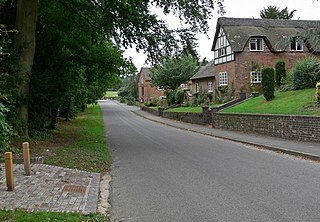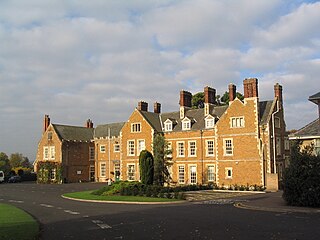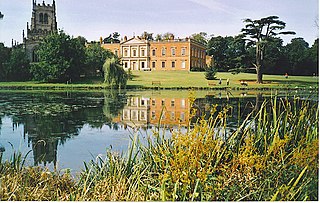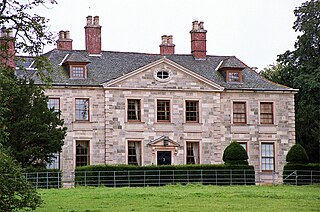
Groby is a village in the Hinckley and Bosworth borough Leicestershire, England. It is to the north west of Leicester. The population at the time of the 2011 census was 6,796.

Hungarton is a small village and civil parish in the Harborough district, in the county of Leicestershire, England, about 10 miles (16 km) north-east of Leicester and 13 miles (21 km) south-west of Melton Mowbray. The population of the civil parish was 269 at the 2001 census, including Ingarsby, and increased to 289 at the 2011 census.

Ashby St Ledgers is a village in the West Northamptonshire district of Northamptonshire, England. The post town is Rugby in Warwickshire. The population of the civil parish at the 2011 census was 173. The Manor House is famous for being a location for the planning of the Gunpowder Plot in 1605. As of 2023, the property had been restored and could be rented for a fee.

Queniborough is an English village in the county of Leicestershire 2.5 miles (4 km) north-east of the town of Syston and of 7.5 miles (12 km) north-east of the city of Leicester. Its 972 properties housed 1,878 registered electors in 2003. The population increased to 2,326 at the 2011 census. It forms part of the Leicester Urban Area due to its proximity. The parish church of St Mary's has, according to the architectural historian Nikolaus Pevsner, "one of the finest spires in the whole of Leicestershire".

Beeby is a village and civil parish in the Charnwood district of Leicestershire, England, with a population of 115 according to the 2011 census. It is situated north-east of Leicester, nearer to the villages of Keyham and Hungarton in the neighbouring district of Harborough and lies along the Barkby Brook. This small rural hamlet can be succinctly described as "a series of scattered houses that remain of the shrunken medieval village". The parish also includes the hamlet of Little Beeby, which consists of several houses within the settlement and is located 200m south east of the All Saints Church.

Bardon is a civil parish and former village in North West Leicestershire about 1.5 miles (2.4 km) southeast of the centre of Coalville. The parish includes Bardon Hill, which at 912 feet (278 m) above sea level is the highest point in Leicestershire. With the population remaining less than 100, information from the 2011 census was included in the civil parish of Ellistown and Battleflat.

Shenton is a village and former civil parish, now in the parish of Dadlington and Sutton Cheney, in the Hinckley and Bosworth district, in the county of Leicestershire, England, situated 2.20 miles (3.54 km) south-west of Market Bosworth. Shenton was formerly a chapelry and township of the parish of Market Bosworth. The settlement is almost entirely agricultural, containing several farms. Much of the land has been in the same family since William Wollaston purchased the manor in 1625. It is essentially a privately owned estate village and has seen comparatively little modern development. It has been designated a conservation area. The settlement lies either side of the Sence Brook, which is crossed by a picturesque Victorian bridge. The area is fairly flat, and subject to flooding. In 1931 the parish had a population of 154.
Garendon Abbey was a Cistercian abbey located between Shepshed and Loughborough, in Leicestershire, United Kingdom.

Garendon Hall was a country home near Shepshed, Leicestershire, England. It was demolished in 1964.

Brooksby Hall is a late–16th-century manor house on 3.2 square kilometres of land between Leicester and Melton Mowbray. Situated 13 kilometres (8.1 mi) northeast of Leicester, the hall and the neighbouring church of St Michael and All Angels are the last remnants of the medieval village of Brooksby, which was founded during the period of the Danelaw in the 9th century AD. In the 15th and 16th centuries Brooksby was depopulated by enclosures carried out by the estate's owners, which turned its cultivated land into sheep pastures in order to profit from a boom in wool.

Staunton Harold is a civil parish in North West Leicestershire about 3 miles (5 km) north of Ashby-de-la-Zouch. The parish is on the county boundary with Derbyshire and about 9 miles (14 km) south of Derby. The 2011 Census recorded the parish's population as 141.

Loddington is a village and civil parish in the Harborough district of Leicestershire. It is on the county boundary with Rutland, and the nearest town is Oakham in Rutland, 6 miles (10 km) to the northeast.

Donington le Heath is a village on the River Sence just over 1 mile (1.6 km) south of the centre of Coalville in North West Leicestershire. Donington is contiguous with the village of Hugglescote immediately to the east. The population of the village is included in the civil parish of Hugglescote and Donington le Heath.

The Grace Dieu Priory was an independent Augustinian priory near Thringstone in Leicestershire, England. It was founded around 1235-1241 by Roesia de Verdun and dissolved in October 1538. It was dedicated to the Holy Trinity and St Mary. Today the site is managed by the Friends of Grace Dieu Priory, a charitable group of volunteers who fundraise to care for the site, and keep it open to the public for free.
Grace Dieu Manor is a 19th-century country house near Thringstone in Leicestershire, England, occupied by Grace Dieu Manor School until 2020. It is a Grade II listed building.

Gaddesby Hall is an 18th-century brick-built house in the village of Gaddesby, Leicestershire. It was built in the late 1740s as a three-storey house with additions of 1868. It is a Grade II listed building.

Humberstone and Hamilton is an electoral ward and administrative division of the City of Leicester, England. It comprises the north-eastern Leicester suburbs of Humberstone, Humberstone Garden City, Hamilton and Netherhall.

Baggrave Hall is an 18th-century Grade II* listed country house in the parish of Hungarton, Leicestershire, England. It is a two and three-storey building in Palladian style, constructed in ashlar in the 1750s, with a Swithland slate hipped roof and brick-ridge chimney stacks. An extra wing in red brick can be dated to 1776. The current grounds cover 220 acres. The hall was listed in 1951, but suffered serious damage from an owner in 1988–1990.
Shukburgh or Shuckburgh Ashby was a British landowner and politician.

Bradgate House is a 16th-century ruin in Bradgate Park, Leicestershire, England.


















